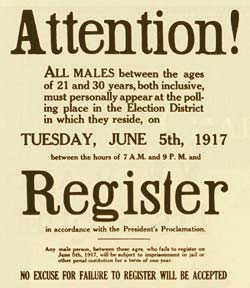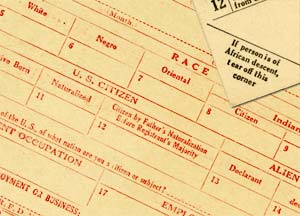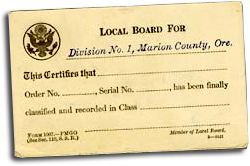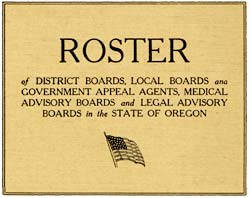Do I Have To Register For The Draft In Oregon

Settling on a Draft
With the proclamation of state of war in April 1917, American leaders had to make decisions about how to mobilize millions of men for military service. Many people, such equally former president Teddy Roosevelt, held a romantic attachment to voluntary armed forces service. And certainly, America'due south feel with a system of conscription or compulsory military service during the Marriage draft of the Civil State of war was seen as an example of how non to raise an army. That typhoon resulted in gross unfairness through the hiring of substitutes and other dubious actions, spawning protests and riots.
In the end, President Wilson and his advisors settled on the typhoon as the only efficient and democratic way to enhance a large regular army. In contrast to the Ceremonious State of war typhoon, Wilson sought to spread the obligation for duty amidst all qualified men, regardless of their social or economic continuing. The Selective Service Act required all males from 21 to 30 become to their ballot precinct polling identify to register in early on June 1917. Afterward, men were expected to announced when they turned 21 years old. In 1918 typhoon ages were expanded to include those anile 18 to 45. By the end of the state of war, more than 24 million men registered for the typhoon with almost 3 million being inducted into the Army.
No Alibi for Failure to Register

The Selective Service Section set upwardly district boards in Portland, Eugene, and La Grande. Each of these had jurisdiction over a number of local typhoon boards. Because of Portland's size, it included 10 local lath divisions. Marion County had two. Otherwise, the boards were located in each of Oregon'due south canton seats.
Registering for the draft was a long and bureaucratic exercise. Numerous forms and cards waited for completion. A 16 page questionnaire walked through almost every aspect of a registrant'south life. Failure to fill it out within seven days could result in a "fine or imprisonment for i year and may event in the loss of valuable rights and firsthand induction into military service."
The first, and probably almost important, question against the registrant was that of making a claim for exemption or deferred nomenclature from the typhoon. The law held that "the names of all men liable to pick for military service shall be arranged in five classes in the order in which they tin can all-time be spared from the civic, family unit, industrial, and agronomical institutions of the Nation." In simplified course, the system included:

- Grade I: Every man in this form was "presently liable for military service." These included most single men, unskilled laborers, and certain married men.
- Class II: These men were "temporarily deferred" from service until Class I was exhausted. They mostly included certain married men with dependents and "necessary" skilled labor.
- Class Iii: These men were "temporarily deferred" from service until Class Ii was wearied. They generally included sure men with dependent infirm or "helpless" relatives besides as certain types of government workers and other "necessary" workers.
- Form IV: These men were "temporarily deferred" from service until Grade Iii was wearied. They by and large included men with families that were "mainly dependent on his labor for support" likewise equally merchant mariners and managers of "necessary enterprises."
- Class V: These men were "exempted or discharged" from service. They generally included legislative, executive, or judicial officers of government, ministers, aliens, the "totally and permanently physically or mentally unfit" equally well as the "morally unfit."
A separate line allowed for a claim of exemption based on religious convictions against participating in state of war - the conscientious objector.
The remainder of the questionnaire asked detailed questions, 32 on dependents alone, related to supporting claims made for exemption or deferred classification and required affidavits in support. Legal advisory boards, consisting of "disinterested lawyers and laymen" were available at typhoon lath offices throughout Oregon to advise registrants on the "true meaning and intent" of the law. View draft registration questionnaire (PDF).
Your Local Typhoon Board
In one case the forms and questionnaires were completed, the local draft lath would brainstorm processing the registration and a folder would fill with the resulting paperwork, noting each footstep of the process. If the registration progressed to the point at which the registrant were ordered to written report for a concrete exam, the report of the examining physician would be included, equally would the report of the medical advisory lath. Twenty-v of these boards scattered throughout Oregon examined records and determined the physical qualifications of the registrants. They had four choices: qualified; qualified but deferred; qualified for express service; and disqualified. The medical board's determination was forwarded to the local draft board, which ruled on the same criteria. If the private appealed the activeness, the district draft board would dominion.

Registrants who passed the physical examination would exist ordered to study for service. If they failed to report, they first would be listed as delinquent and afterward as deserters who were to be "apprehended." Those who reported every bit ordered eventually would notice themselves at mobilization camp where they would be either accustomed, rejected, or discharged.
Of course, for those not immediately inducted into the military, there were continuing responsibilities related to the draft. If any change occurred that could touch on their deferred or exempt status, they were to report information technology to the local typhoon board within v days. They were also required to examine "from fourth dimension to fourth dimension" notices posted by the local draft board in case changes to the system affected their status.
Results May Vary
The public voiced picayune opposition to the draft over the course of the war. Some of this could exist attributed to fearfulness of criticizing a government that was starting time to crack downwards on "disloyal" rhetoric. Just most Americans saw the need for the draft and believed that, while not perfect, the classification system generally was fair. Certainly, equally with any organisation of its size and complexity, favoritism, blackmail, intimidation, and other forms of corruption occurred at local draft boards. But the organisation held up fifty-fifty as it lowered the draft age from 21 to 18, thereby edging closer to the sight of "taking boys from their mothers' artillery."
Opinions differed on the quality of the soldier produced by the typhoon. Overall, consensus holds the drafted soldiers fought only as heroically as the 2 million men who enlisted in the various war machine. But at least ane Oregon man, Martin Luther Kimmel, who had enlisted in the Regular army held a different attitude:
Notes
(Oregon State Defense Council Records, Publications and Ephemera, Box 9, Folder ane; State Historian's Correspondence, Box one, Folder xv; Oregon Historical Quarterly, vol. 75, folio 265)
Do I Have To Register For The Draft In Oregon,
Source: https://sos.oregon.gov/archives/exhibits/ww1/Pages/home-front-draft-board.aspx
Posted by: salinasdelitth.blogspot.com


0 Response to "Do I Have To Register For The Draft In Oregon"
Post a Comment